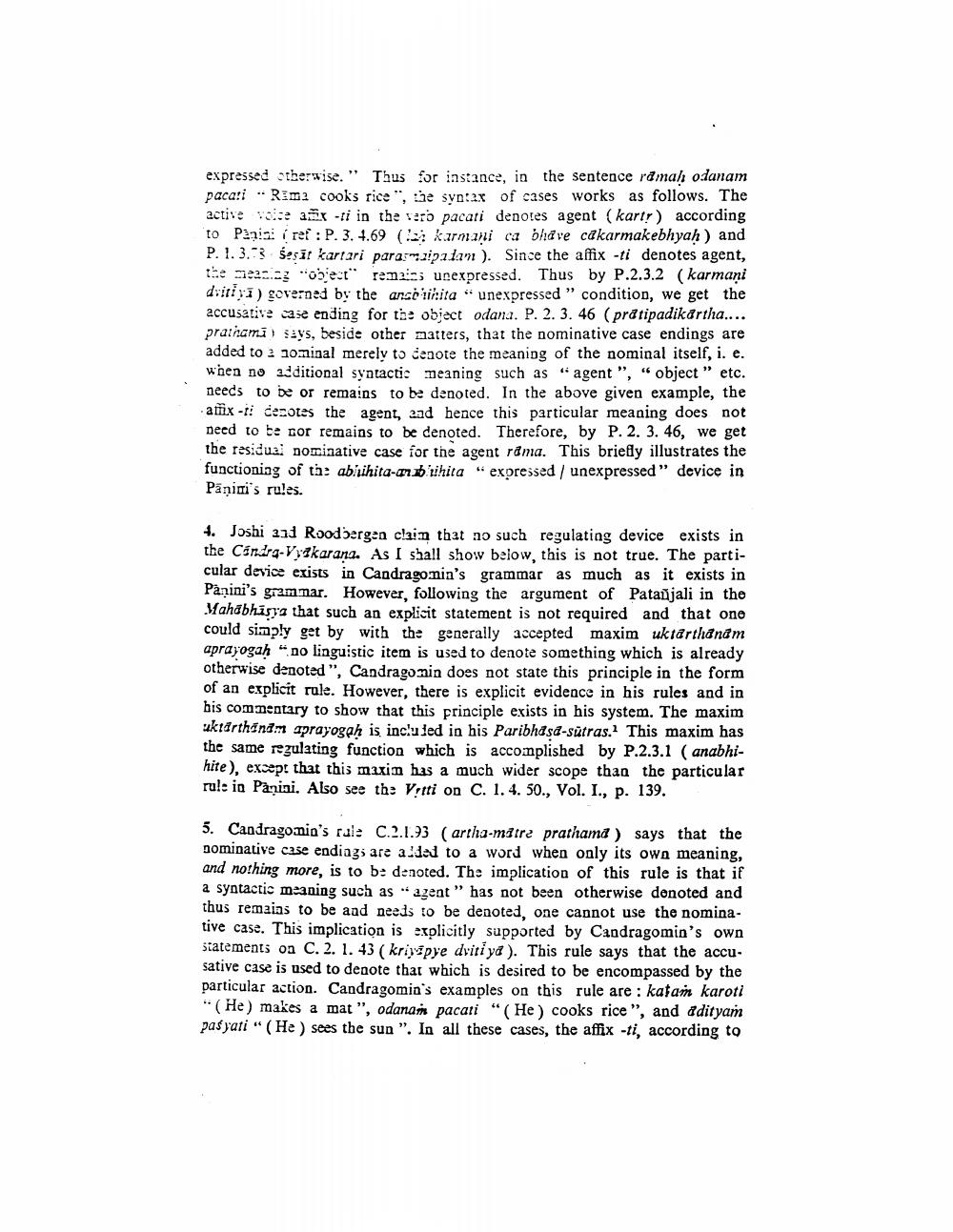Book Title: Candragomins Syntactic Rules Some Misconceptions Author(s): Mahadev Deshpande Publisher: Mahadev Deshpande View full book textPage 2
________________ expressed otherwise." Thus for instance, in the sentence ramah odanam pacati Rima cooks rice", the syntax of cases works as follows. The active voice affix -ti in the vero pacati denotes agent (karty) according to Panini (ref: P. 3. 4.69 ( karmani ca bhave cakarmakebhyaḥ) and P. 1.3.3 Seşit kartari paramaipadam). Since the affix -ti denotes agent, the meaning "object" remains unexpressed. Thus by P.2.3.2 (karmani dvitiya) governed by the ansehihita "unexpressed" condition, we get the accusative case ending for the object odana. P. 2. 3. 46 (pratipadikartha.... prathama says, beside other matters, that the nominative case endings are added to a nominal merely to denote the meaning of the nominal itself, i. e. when no additional syntactic meaning such as "agent", "object" etc. needs to be or remains to be denoted. In the above given example, the affix - denotes the agent, and hence this particular meaning does not need to be nor remains to be denoted. Therefore, by P. 2. 3. 46, we get the residual nominative case for the agent rama. This briefly illustrates the functioning of the abhihita-anabihita "expressed / unexpressed" device in Panini's rules. 4. Joshi and Roodbergen claim that no such regulating device exists in the Candra-Vyakarana. As I shall show below, this is not true. The particular device exists in Candragomin's grammar as much as it exists in Panini's grammar. However, following the argument of Patanjali in the Mahabharya that such an explicit statement is not required and that one could simply get by with the generally accepted maxim uktarthanam aprayogaḥ no linguistic item is used to denote something which is already otherwise denoted ", Candragomin does not state this principle in the form of an explicit rule. However, there is explicit evidence in his rules and in his commentary to show that this principle exists in his system. The maxim uktärthanam aprayogah is included in his Paribhasa-sutras.1 This maxim has the same regulating function which is accomplished by P.2.3.1 (anabhihite), except that this maxim has a much wider scope than the particular rule in Panini. Also see the Vitti on C. 1. 4. 50., Vol. I., p. 139. 5. Candragomin's rale C.2.1.93 (artha-matre prathama) says that the nominative case endings are added to a word when only its own meaning, and nothing more, is to be denoted. The implication of this rule is that if a syntactic meaning such as "agent" has not been otherwise denoted and thus remains to be and needs to be denoted, one cannot use the nominative case. This implication is explicitly supported by Candragomin's own statements on C. 2. 1. 43 (krivipye dvitiya). This rule says that the accusative case is used to denote that which is desired to be encompassed by the particular action. Candragomin's examples on this rule are: katam karoti (He) makes a mat", odanam pacati "(He) cooks rice", and adityam pasyati "(He) sees the sun ". In all these cases, the affix -ti, according toPage Navigation
1 2 3 4 5 6 7 8 9 10 11 12 13
